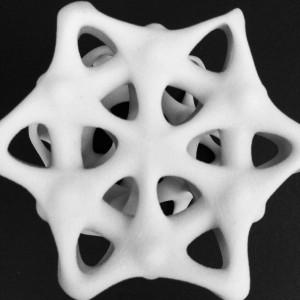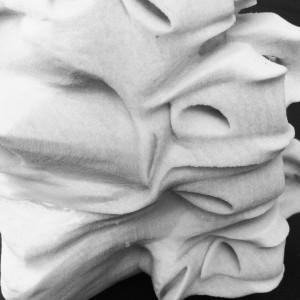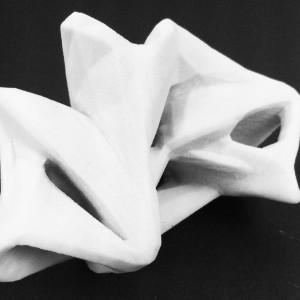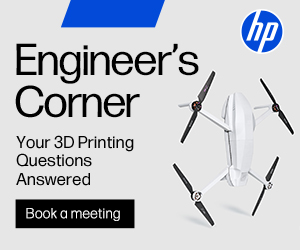3D Printed Species Encourage Students to Evolve Form in Design of Dwelling
This semester, students in Professor James Kerestes graduate design studio course at Ball State University are using advanced digital fabrication technology to explore iterative form finding, from the initial conceptual stages, to a highly developed finished design for a dwelling in Philadelphia. The project is given to the students as a series of assignments over the course of a semester. The project allows the students to explore form as an exercise in and of itself, without defaulting to a series of pre-existing responses to any aspect of the problem of creating a dwelling.
In fact, Professor Kerestes elected to name the project ‘Dwelling’ in a further attempt to distance the students from preconceived notions regarding the creation of the architecture of a house, and asked them to focus on reimagining spaces for living from their most fundamental aspects. Kerestes explained his approach:
“The students are designing for a traditional residential block in Philadelphia, where most of the row houses are two story, brick construction homes. I shy away from using the word house because I want the students to challenge the typology of the ‘house,’ specifically the traditional row house style of Philadelphia. This is so that the students develop a dwelling that is more ecologically in tune with the specific context of the area.”
In order to undertake the explorations, the students learn in depth how to utilize, and possibly even misuse, software in order to become experts at the application of techniques to generate new results. Students continually revisit the form that they begin with in order to morph it within a changing set of circumstances. Kerestes encourages them to think of their form as a species and uses the metaphor of evolution to guide their explorations:
“Like in evolution, the students will place their existing, abstract forms into the site and have it adapt to the context around it, similar to the zebra in Africa, which is basically a horse that has responded to its environment and predators to physiologically change for survival. In principle, we are simulating the same kind of adaptive process.”
The students use the Maya workspace to study and generate their forms. The students input their design operations in order to understand the way in which they can cause the form to adapt and evolve over time. One phase of this assignment requires that the students take the form with which they have been working and study the way in which it necessarily changes and adapts to the confines of a 4”x4”x4” cube. Rather than accepting the changes as a final product, in keeping with the iterative nature of the studio’s approach, the students 3D print the model and use feedback from studio critique to refine and further develop their digital models.
The benefits of 3D printing to iterative model making are clear in the context of the time constraints of a university semester. Creating these models by hand would make this project prohibitively time consuming whereas the ability to rapidly print from the digital to the physical allows for a greatly compressed timeline of creation, critique, and re-creation. This process also gives the students practice in the skill of building intelligence into their design process and products. Rather than seeing each new constraint or circumstance as a wiping away of what was created, these digital design and fabrication technologies make that flexibility an inherent part of the process of creation.
With this type of extraordinary approach, it is no wonder that Kerestes is serving as the Design Innovation Fellow with Ball State’s Department of Architecture. It will be very interesting to watch how the students who graduate from his studio integrate this type of creative thinking into their own design processes. Let’s hear your thoughts on this projects, in the Dwelling forum thread on 3DPB.com
Subscribe to Our Email Newsletter
Stay up-to-date on all the latest news from the 3D printing industry and receive information and offers from third party vendors.
Print Services
Upload your 3D Models and get them printed quickly and efficiently.
You May Also Like
3D Printing Financials: Stratasys Kicks Off 2025 with Fresh Cash and a Tight Grip on Strategy
Stratasys (Nasdaq: SSYS) started the year with strong momentum, adding fresh cash to its balance sheet and achieving profitability on an adjusted basis. The company also gained a new investor,...
Chaos & Opportunity
Great fortunes are lost and won amidst quicksand. When well-trodden paths turn to labyrinths, the concrete is sublimated into morass, sunshine turns to hail, and 20/20 vision becomes blindness; new...
3D Printing Financials: Xometry Cuts Losses, Grows Platform
Xometry (Nasdaq: XMTR) is entering 2025 with momentum. The company delivered record quarterly revenue and narrowed its losses, showing progress toward profitability. More importantly, for those watching the future of...
3D Spark Secures $2.2M to Tackle Manufacturing Bottlenecks
German startup 3D Spark has raised two million euros in a seed round. Swedish software investor Triplefair Partners led the round, with Fraunhofer Technologie-Transfer Fonds (FTTF) and Innovationsstarter Fonds Hamburg...

































